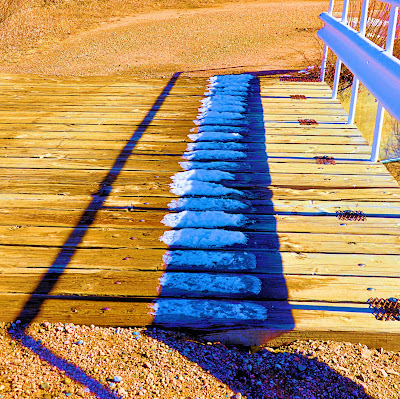 |
| Lines |
Photography has been in my life for as many years as crayons or paints but until lately I saw it primarily as a tool to aid in painting or as a way of recording the events of my life - the scenes that played in the background. But the age of digital photography has changed that. Today I find myself often "painting" in pixels.
Some disdainfully call it photoshopping, or photo manipulation. The spindoctors in the photographic world have come to use the term post processing, and making correlations with dark room processing with film. I tiptoed in and around the subject for some time. I have had a computer program for digital manipulation of images for longer than I had a digital camera. I would have digital images put on a CD when I had my film processed. I used Photoshop to crop, reduce an image to lines to print on watercolor paper for painting, or airbrush out that annoying artifact in a picture. After succumbing to my first digital camera in 2006 (primarily to record my paintings) I explored adjustment of brightness and contrast. Delicately.
My new digital camera having more megapixels requires a bit more playing with brightness/contrast and hue/saturation. It is the nature of the beast. So is my curiosity. What if games ensued primarily with marginal photographs. Take the bridge across Coyote Creek above.
 |
| Coyote Creek Bridge before post processing |
For an artist that has been attracted to patterns and textures since darkroom 101 in college pushing the limits of my Corel Paintshop Pro program was exciting.
 |
| The original shed roof |
 |
| Post processed shed roof |
It also brought out the artist in me. No longer was photography just a way of recording a scene to take to the studio and use as a basis of the painting. It became a digital painting. I have a friend I met at an art fair that takes this one step further. She prints her image on canvas and then adds texture and detail with paint. It becomes hard to tell where the photograph ends and the painting begins. Art fairs are trying to find a term for this new "mixed media." So far I don't think they have exactly hit on the fact that it is just photography until you add the paint.
 |
| Volkswagen original image |
 |
| Volkswagen post processed |
The key in "digital art" as in all art is the artist. There exists those that think because the world has invented another technical tool they can do it. But if they don't have the eye to take the original photograph or manipulate it correctly no amount of technical toys will help. Photo manipulation programs are just darkrooms for the modern photographer. And at no time since the advent of complex color film kicked us out of the basement darkroom have we had such control over our final image.
There are the purists that think Ansel Adams would be rolling over in his grave. But he was as fond of darkroom manipulation of his image as most were in the day of B&W film. I think he would be ecstatic about post processing on a computer. But he also would not toss out the importance of the original image. No amount of digital manipulation will turn a bad photograph into a great photo image. You have to have an artist's eye.
I very much enjoyed your perspective.
ReplyDeleteIt seems that just the word “photograph” can instil a Pavlovian response in many people irrespective of their knowledge.
I would much prefer if people could get over this particular hang-up and just think in terms of “image.”